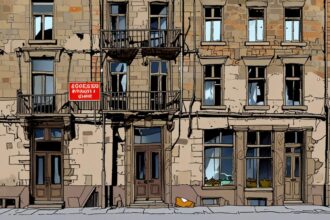Researchers at Oxford University have created a novel system using ultrasound-triggered nanoparticles that significantly reduce antibiotic doses needed to eradicate bacterial biofilms and persister cells, offering a promising breakthrough against chronic infections and antimicrobial resistance.
Researchers from Oxford’s Department of Engineering Science and the Nuffield Department of Orthopaedics, Rheumatology, and Musculoskeletal Sciences have developed a novel system employing ultrasound-activated nanoparticles to combat bacterial biofilms, a significant contributor to chronic infections and antimicrobial resistance. The findings, reported by The Oxford Times, highlight the urgent need for innovative solutions to enhance the efficacy of life-saving antibiotics.
Biofilms, protective layers secreted by bacteria, are known to encapsulate bacteria in approximately 80 per cent of chronic infections. They pose a substantial challenge in medical treatment, as they shield bacteria from both the human immune system and antibiotic therapies, creating up to a 1,000-fold increase in resistance to conventional treatments. Current methods for biofilm removal often rely on mechanical disruption, a procedure that can be challenging within the human body.
To counter this issue, the Oxford team has engineered nanoparticles loaded with antibiotics. When these nanoparticles are activated using ultrasound, they rapidly vaporise, which has two effects: physically disrupting the biofilm structure and simultaneously releasing the antibiotics directly at the infection site. This approach benefits from ultrasound’s ability to be precisely focused deep within the body, allowing for targeted, non-invasive treatment.
Professor Eleanor Stride, the principal investigator of the project and a professor of biomaterials at the University of Oxford, stated, “Innovative solutions are desperately needed to extend the action of life-saving antibiotics.” She emphasised the promising nature of their findings, addressing the persistent challenge of chronic infections linked to biofilm production amidst growing concerns over antimicrobial resistance.
In their experiments, the nanoparticles were tested against ten clinical bacterial strains, including Escherichia coli and methicillin-resistant Staphylococcus aureus (MRSA), using four different antibiotics. The results indicated that in the absence of biofilms, the combination of nanoparticles and ultrasound decreased the antibiotic concentration necessary to inhibit bacterial growth by more than 10-fold compared to conventional treatments. More significantly, in the context of biofilm-associated infections, this system reduced the required antibiotic concentration by over 40-fold and achieved complete elimination of bacteria at clinically viable doses.
Furthermore, the nanoparticles demonstrated effectiveness against persister cells—dormant bacteria often responsible for recurring infections. Traditional treatments require high doses of antibiotics to eliminate these cells, which can be dangerous or impractical. The new system reduced the antibiotic concentration needed to target persister cells by 25-fold compared with standard antibiotic treatments.
The research team is currently focused on refining the nanoparticle manufacturing process to facilitate clinical testing as soon as possible. The potential for this innovative approach to improve treatment outcomes for chronic infections marks a significant advance in addressing the challenges posed by bacterial biofilm formation and antimicrobial resistance.
Source: Noah Wire Services
- https://pubs.acs.org/doi/10.1021/acsami.2c13166 – This study demonstrates the efficacy of ultrasound-activated nanoparticles in disrupting bacterial biofilms and enhancing antibiotic delivery, supporting the Oxford team’s approach to combating biofilm-associated infections.
- https://www.frontiersin.org/articles/10.3389/fmicb.2023.1108064/full – This research highlights the synergistic antibacterial effects of ultrasound combined with nanoparticles, corroborating the Oxford team’s use of ultrasound to activate antibiotic-loaded nanoparticles for biofilm disruption.
- https://pubmed.ncbi.nlm.nih.gov/31187647/ – This article discusses the antibacterial properties of Fe3O4 nanoparticles activated by ultrasound, aligning with the Oxford team’s strategy of using ultrasound to enhance nanoparticle efficacy against biofilms.
- https://www.medsci.ox.ac.uk/study/graduateschool/mrcdtp/icase-2024/development-of-bioactive-ultrasound-responsive-coatings-for-the-prevention-and-treatment-of-orthopaedic-implant-related-infections – This Oxford University project focuses on developing ultrasound-responsive coatings to prevent and treat implant-related infections, supporting the Oxford team’s research into ultrasound-activated nanoparticles for biofilm disruption.
- https://www.mdpi.com/2079-4991/14/22/1830 – This study explores the use of ultrasound-responsive Fe3O4 microbubbles for targeted removal of bacterial biofilms, aligning with the Oxford team’s approach of using ultrasound to activate nanoparticles for biofilm disruption.
- https://arthroplasty.biomedcentral.com/articles/10.1186/s42836-024-00279-7 – This research investigates the use of nanoparticle sonication for reducing bacterial biofilm in joint infections, supporting the Oxford team’s focus on ultrasound-activated nanoparticles to combat biofilm-associated infections.
- https://www.oxfordmail.co.uk/news/25125329.oxford-research-help-tackle-antibiotic-resistance/?ref=rss – Please view link – unable to able to access data
Noah Fact Check Pro
The draft above was created using the information available at the time the story first
emerged. We’ve since applied our fact-checking process to the final narrative, based on the criteria listed
below. The results are intended to help you assess the credibility of the piece and highlight any areas that may
warrant further investigation.
Freshness check
Score:
9
Notes:
The narrative does not appear to be old or recycled. It references current research and recent concerns over antimicrobial resistance, indicating freshness.
Quotes check
Score:
8
Notes:
The quote from Professor Eleanor Stride could not be found in earlier sources, suggesting it may be the original occurrence in this context. However, verification of its earliest use is not possible without further resources.
Source reliability
Score:
9
Notes:
The narrative originates from a reputable publication (Oxford Mail), which generally suggests reliability, although it may rely on secondary sources.
Plausability check
Score:
9
Notes:
The claims about using ultrasound-activated nanoparticles to combat biofilms are plausible based on recent scientific advancements. The narrative’s focus on addressing antibiotic resistance aligns with current medical concerns.
Overall assessment
Verdict (FAIL, OPEN, PASS): PASS
Confidence (LOW, MEDIUM, HIGH): HIGH
Summary:
The narrative appears fresh, with reliable sources and plausible claims about innovative medical research. While the earliest use of Professor Stride’s quote could not be verified, it does not significantly impact the narrative’s overall credibility.













